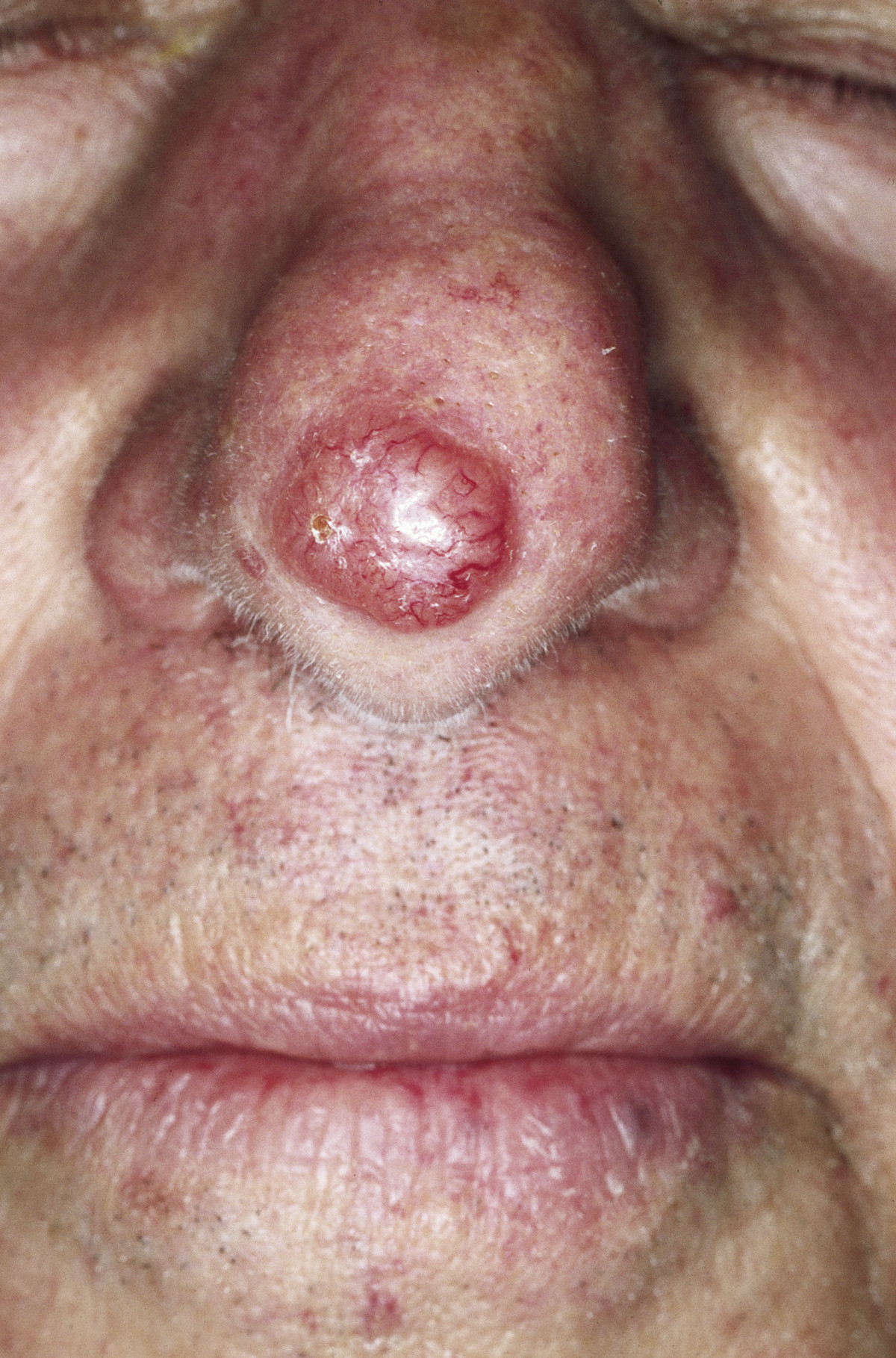Playlist
Show Playlist
Hide Playlist
Basal Cell Carcinoma (BCC, Basal Cell Cancer)
-
Slides Dermatology Neoplastic Skin Diseases.pdf
-
Download Lecture Overview
00:01 Here’s our first neoplastic condition of the skin. 00:05 It is the most common cancer worldwide or, in other words, it’s the most common cancer in the human species. 00:14 Welcome to basal cell carcinoma. 00:16 Let’s talk about this in greater detail. 00:18 Chronic intermittent UV exposure might be a possible risk. 00:23 Next, work with me here, what does the basal layer mean to you? The basal layer will be the bottom most layer of your epidermis, right? Bottom most layer. 00:33 Morphology: Pearly papule or a nodule. 00:38 Stop there and make sure you know the description morphologically for basal cell carcinoma. 00:43 Often, often with central ulceration umbilication on sun-exposed skin. 00:48 And as a rule of thumb, BCC usually will appear above the upper lip and usually by the nose, by the nasolabial type of fold as I should show you soon. 01:00 But really, it could be any area of the skin in which there is exposure to UV rays. 01:06 Now with BCC, very, very low risk of going on to metastasis. 01:11 For all intent and purposes, can we just say, it’s null and void. 01:14 Granted, it could be 0.05% risk of going on to -- a 0.05% risk of going on to malignancy. 01:23 But with that said, just because it’s a benign condition, it does not mean that it’s not dangerous. 01:28 And I’ve talked to you about this earlier. 01:30 Meaning to say that you could have a benign condition in which, my goodness, it’s locally aggressive. 01:35 So say that there is an umbilicated type of lesion that is pearly and papule that is located here, with the exposure of UV rays in a Caucasian patient. 01:45 What are you worried about? You’re worried about that benign papule which is going to grow, grow, grow very, very quickly. 01:50 And what’s it going to do? Might encompass the entire nasal region and destroy everything in its path, completely disfiguring the face of your patient. 01:59 Not good, okay? So just because you don’t say that it metastasizes and the fact that this particular-- in terms of benign and malignancy, let’s just air on the diagnosis and malignancy. 02:13 The chance of metastasis is extremely rare, but locally extremely aggressive to the point where it may disfigure your face. 02:22 Something you want to keep in mind. 02:24 So on BCC, what may happen? Well here’s a picture of exactly of what I’m referring to. 02:30 Here’s a picture in which a BCC which almost never metastasizes, if it grows locally very quickly, it is then going to start disfiguring the face. 02:41 The demographics, it is most common cancer of all mankind. 02:46 Big deal. 02:49 Occurs on sun-exposed areas of older adults. 02:53 Locally aggressive, although slow-growing. 02:56 And can be disfiguring with extension, growth and as I said, very rarely does it metastasize, less than 0.05%. 03:07 Now with BCC, there are couple of histologic descriptions that you’re very much want to keep in mind. 03:13 Proliferation of the basophilic cells arising where? Basal cell carcinoma from the basal epidermis infiltrating the dermis. 03:23 So if you’re already so incredibly close to the dermis and you have involvement of the basal cells already undergoing neoplastic proliferation, do you see as to how easy it is to go in the dermis? As you see in the histologic picture here. 03:38 Whereas cells also resembled the stratum basale of normal skin as you can imagine. 03:45 Basal cell carcinoma, allow the name to speak to you, please. 03:49 Management: Superficial forms. 03:52 So we'll talk about the different forms a little bit and quickly as to how you want to manage these. 03:56 Curettage and perhaps electrodessication, superficial form. 04:00 Excision or maybe perhaps Imiquimod Cream is all part of management of the superficial form. 04:08 The all other forms of basal cell carcinoma: Excision and consider micrographically controlled surgery if we’re talking about BCC which is becoming incredibly aggressive.
About the Lecture
The lecture Basal Cell Carcinoma (BCC, Basal Cell Cancer) by Carlo Raj, MD is from the course Neoplastic Skin Diseases.
Included Quiz Questions
An elderly man has a skin lesion on his temple that is a light-pink papule with telangiectatic vessels within it. The periphery is more raised than the middle. What is a likely diagnosis?
- Basal cell carcinoma
- Squamous cell carcinoma
- Melanoma
- Hemangioma
- Psoriasis
Which of the following skin conditions can be locally aggressive?
- Basal cell carcinoma
- Cherry hemangioma
- Seborrheic dermatitis
- Psoriasis
- Seborrheic keratosis
Customer reviews
5,0 of 5 stars
| 5 Stars |
|
5 |
| 4 Stars |
|
0 |
| 3 Stars |
|
0 |
| 2 Stars |
|
0 |
| 1 Star |
|
0 |




